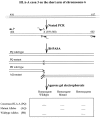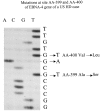Epstein-Barr virus (EBV) nuclear antigen (EBNA)-4 mutation in EBV-associated malignancies in three different populations
- PMID: 10487851
- PMCID: PMC1866909
- DOI: 10.1016/S0002-9440(10)65193-0
Epstein-Barr virus (EBV) nuclear antigen (EBNA)-4 mutation in EBV-associated malignancies in three different populations
Abstract
Different ethnic groups with a high human leukocyte antigen (HLA)-A11 prevalence have been shown to experience a high rate of Epstein-Barr virus (EBV) infection, EBV-associated malignancies, and Epstein-Barr nuclear antigen (EBNA)-4 mutations. The epitopes 399-408 and 416-424 of EBNA-4 are major antigenic epitopes that elicit an HLA-A11 cytotoxic T lymphocyte (CTL) response to EBV infection. Mutations selectively involving one or more nucleotide residues in these epitopes affect the antigenicity of EBNA-4, because the mutant EBV strains are not recognized by the HLA-A11-restricted CTLs. To investigate these mutations in common EBV-associated malignancies occurring in different populations, we studied the mutation rate of epitopes 399-408 and 416-424 of EBNA-4 in 25 cases of EBV-associated Hodgkin's disease (HD), nine cases of AIDS-related non-Hodgkin's lymphoma, and 37 cases of EBV-associated gastric carcinoma (GC) from the United States, Brazil, and Japan. We found one or more mutations in these two epitopes in 50% (6/12) of United States HD, 15% (2/13) of Brazilian HD, 50% (6/12) United States GC and 28% (7/25) Japanese GC, and 22% (2/9) of United States AIDS-lymphoma. Similar mutations were found in 30% (3/10) of United States reactive, 0% (0/6) of Brazilian reactive, and 25% (2/8) Japanese reactive tissues. The most frequent amino acid substitutions were virtually identical to those seen in previously reported isolates from EBV-associated nasopharyngeal carcinomas and Burkitt's lymphomas occurring in high prevalence HLA-A11 regions. However, only 2/28 (7%) mutations occurred in HLA-A11-positive patients. Our studies suggest that: 1) EBNA-4 mutations are a common phenomenon in EBV-associated HD, GC, and AIDS-lymphoma; 2) the mutation rate does not vary in these geographic areas and ethnic groups; 3) EBNA-4 mutations in EBV-associated United States and Brazilian HD, United States and Japanese GC, and United States AIDS lymphomas are not related to patients' HLA-A11 status.
Figures





References
-
- Moss DJ, Rickinson AB, Pope JH: Long-term T-cell-mediated immunity to Epstein-Barr virus in man. III. Activation of cytotoxic T cells in virus-infected leukocyte cultures. Int J Cancer 1979, 23:618-625 - PubMed
-
- Wallace LE, Rickinson AB, Rowe M, Epstein MA: Epstein-Barr virus-specific cytotoxic T-cell clones restricted through a single HLA antigen. Nature 1982, 297:413-415 - PubMed
-
- Murray PG, Constandinou CM, Crocker J, Young LS, Ambinder RF: Analysis of major histocompatibility complex class I, TAP expression, and LMP2 epitope sequence in Epstein-Barr virus-positive Hodgkin’s disease. Blood 1998, 92:2477-2483 - PubMed
-
- Nowak MA, Bangham CR: Population dynamics of immune responses to persistent viruses. Science 1996, 272:74-79 - PubMed
MeSH terms
Substances
LinkOut - more resources
Full Text Sources
Medical
Research Materials
Miscellaneous

